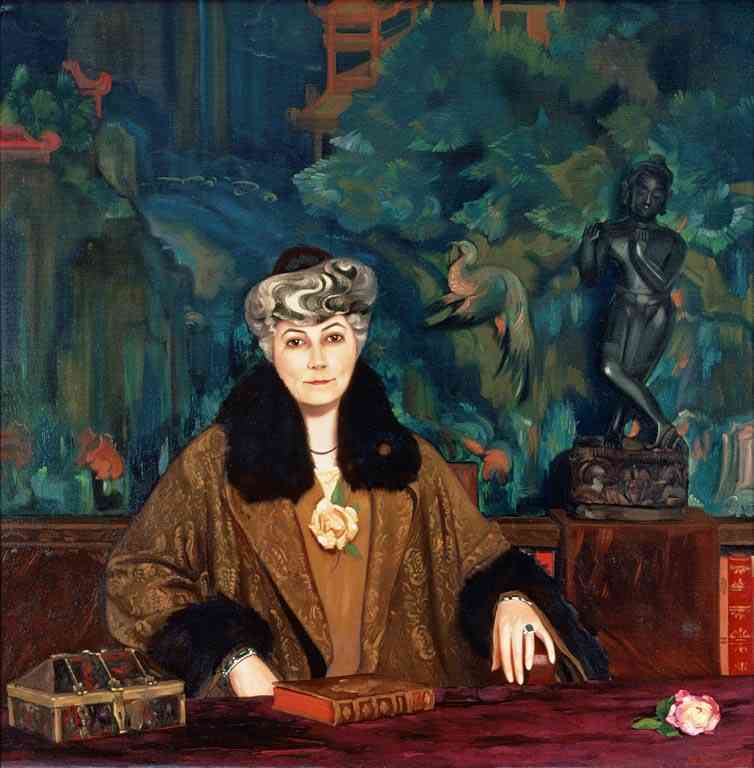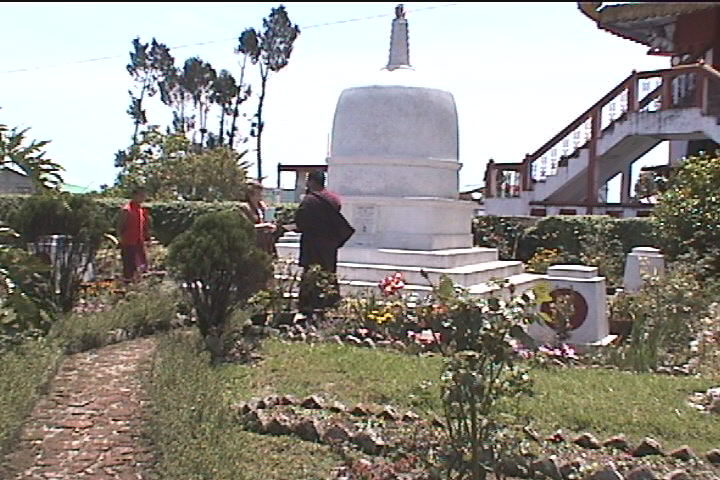 |
 Helena Roerich painted by her son Svetoslav Roerich |
Helena Roerich was born in Russia on February 12, 1879, the daughter of a prominent architect. She was very sensitive and frequently ailing. During illnesses, two very tall men would appear to her with help, but when the grownups objected to her accounts of them, she learned to keep her thoughts to herself. Her mother's sister, princess Putyatine, had an estate at Bologoye where little Helena spent her summers. All the domestic animals rushed to welcome her in the mornings when she would go out to feed them.

In 1915, Nicholas became ill with pneumonia and they left their home in Petersburg for a better climate. In 1918 they went to England and in 1920 came to New York for Nicholas' first exhibition in the United States. By this time Helena was already in contact with Master Morya and the first Agni Yoga book: Leaves of Morya's Garden was written.
During their eventful life, they went to India where they organized their central Asiatic expedition through India, China, Tibet, Mongolia and other countries. Both her husband Nicholas and son George wrote books about their adventures. Although Helena was an active participant, few personal details are known except that she never stopped writing, teaching, and helping others. Besides the thirteen published Agni Yoga books, she wrote numerous letters to disciples and aspirants all over the world. Some of these letters are published in her Letters of Helena Roerich, volumes I & II. She also wrote On Eastern Crossroads and Foundations of Buddhism, using different pseudonyms for each one.

Today thousands of people are gaining help and inspiration from her books, especially from the Agni Yoga series. Her books are seriously studied in every country of the world.

Her memorial stupa can be found near a monastery overlooking the Himalayan Mountains in Kalimpong.
Her books and those of Nicholas Roerich are available through the White Mountain Bookstore.
![]()
QUOTATIONS FROM HELENA ROERICH:
The following quotations, with the exception of the first few which are from a book published by WMEA, are from a few of the published Agni Yoga books that Helena Roerich brought to the world. They and the two volume Letters of Helena Roerich are available from the Agni Yoga Society, Inc., 319 West 107th Street, New York, New York 10025. All quotations are copyrighted. All quotations are reprinted by permission from the Agni Yoga Society. All rights reserved.
![]()
From At the Threshold of the New World:
Dreams, Visions and Letters of Helena Roerich.
April 11th
"The refraction of rays yields sounds that enter into the symphony of the music of the spheres. One may picture their crystalline quality of subtleness coupled with the power of the whirlwind. There is a center in the brain that is called the bell. Like a resonator it gathers the symphony of the world, and it can transform the deepest silence into a thundering chord. It is said: 'He who hath ears, let him hear.' Similarly the spinal chord is called the spear, because if We wish to parry the blows We must strain this channel. Similarly the centers of the shoulders are called wings, because during a self-sacrificing podvig their rays intensify. The legend concerning wings is highly symbolic. Likewise, it was a favorite custom of the ancients to wear a round metal plate upon their breasts. The crown of the head is termed the well, because the waves of outside influences penetrate by this way. Everywhere in antiquity we see the covering of the head connected with the symbol of the priest, whereas now this symbol is replaced by the name of a business firm. So men have become spiritually bald." (p. 104)
Self-confidence; self-conceit; simplicity
April 9th
"Urusvati may calmly accept everything. Inasmuch as self-confidence in action is blessed, so is self-conceit ruinous. Self-conceit is hostile to simplicity. Even great minds are subject to this malady and must return an additional time to labor until they eradicate this husk. No member of the Brotherhood suffers from this. One of the impeding conditions is lack of simplicity. One can wear bast shoes and still not be simple. In simplicity one can build the greatest Temple. Simplicity, beauty, and fearlessness - Christ and Buddha spoke of nothing more. And it is a blessing of the spirit vibrates to these Teachings." (p. 101)
Healing; Color; Flowers
January, 1924
"….Song brings us health, and color will heal wounds. Therefore, I say, happy are those who understand sound and color. From the very beginning the prophets have noted sound and color. The ancient instruction about the ringing of bells is full of meaning. Wreaths and garlands recall the understanding of healing power. According to the color of his radiation, each one is attracted to certain flowers. White and lilac have affinity with violet, blue with the blue; therefore, I advise to keep more flowers of these colors in the room. One can do this with living flowers. Plants wisely selected according to color are more healing. I advise to have more freesias. I love them too. Let these flowers serve as My Sign. Our Ray, with its silveriness, is more reminiscent of white flowers. Urusvati brought her flowers as an offering to Me. Color and sound are Our best repast." (p. 79)
New Era…basis of
October 12, 1949
"…New Era, which is based on cooperation, equal rights, respect for labor, enlightenment, and on the perception of the beauty of Spiritual Leadership in its myriad manifestations of primal, or psychic energy." (p. 225)
New Era…began
November 1, 1949
"The New Era began on the 17th of October, when the enemy was driven out of our Solar System.
'The new constructive work will begin under My Rays.'" (p. 229)
ACCEPTANCE OF THE TEACHING OF LIVING ETHICS-
FINDING THE TEACHER
"In the question of the acceptance of a disciple, his karma plays the main role. Precisely, in connection with discipleship it is most essential to realize the law of Karma and to comprehend it in all respects. Thus, a person overburdened with karma cannot hope to become a close disciple. Only those whose earthly karma is almost completed can be accepted among the closest disciples. There are few who realize what a heavy burden the Teacher takes on by accepting a disciple.
"The Teacher will have no doubt about the student, for accepted students are those who have gone through and purified themselves through many fiery tests, and who in this life have again displayed their readiness, devotion and self-denial not in conditions of comfort but on the edge of the abyss. Precisely those whose high spiritual centers are not only open but are undergoing the fiery transmutation. Hence the small number of the closest disciples.
"You may ask what the burden of the Teacher is. I assure you that it is terrible. By accepting a disciple, the Teacher includes him in his consciousness and establishes with him an invisible but active bond. From that very moment, the Teacher knows at any instant what is happening to his disciple. He can even know his fleeting thoughts, and can direct him accordingly. Therefore, it must be understood how hard, how unbearable for the High Consciousness of the Teacher would be any disharmonious vibrations caused by unpurified thoughts of the disciple, how inadmissible under such a close, sacred bond with the Teacher would be any still-not-outlived lust. Every disharmonious vibration cuts into the current of this bond, and if repeated can break it altogether. But each severing of the thread, occultly speaking, is most painful and brings its consequences. Of course, the pain is entirely different for the Teacher from what it is for the disciple. That is why the acceptance of the disciple is carried out with the greatest caution and is considered the granting of the greatest privilege."2
"You write that it is clear to you that `it is not the disciple who awaits the Teacher, but the Teacher who awaits the disciple,' but I must elucidate this very categorical statement. For every creative activity, for every manifestation, reciprocity and harmony are necessary. Therefore, if there is no expectation there can be no answer. Where there is no expectation there is no striving, but we are told to apply the most vigilant and intensive striving.
"Even so, the great Covenant `When the disciple is ready, the Teacher appears' is seldom understood. There are not many who ask themselves what this readiness actually is. Should not this readiness consist of certain qualities? The trouble is that people do not want to realize that at the foundation of this readiness, and of all the achievements, there is the following of a great ideal, involving a fiery transmutation of all our feelings, of our whole character. People would rather give up various excesses and thoughtlessly, mechanically perform their pranayama, than surrender even one habit that stands in their way to spiritual achievement. But, as it is said, mechanical ways have no value. The transformation of the inner man cannot be achieved automatically, and this transformation is the chief aim of all the true Teachings.'3
"...[A]nd their only consideration is the concentration on the chosen Great Ideal, on the unwavering and constant striving to approach it. Such concentration continues unceasingly. Whatever such a yogi or disciple is doing, his thought is always occupied by his Idea. Everything is performed in the name of this Ideal, and he always feels in his heart the love and the presence of this Image. This is the real concentration indicated by the esoteric philosophy, which deals only with the inner world, the world of Nourmena.
"The same is true regarding the prayer of a disciple; it is precisely this same unceasing striving of the heart, and being in the presence of the chosen Image.
"When such a constant presence of the chosen Image comes into the life of a disciple, when there is no further deviation, then there is true readiness; the Teacher appears and the disciple under observation is accepted.
"After accepting a disciple, the Teacher creates an unseen union with him and includes him in his consciousness. In other words, from that very moment the Teacher knows everything about the disciple. He can know every thought and feeling, even the most transient, and accordingly He can guide his disciple. As for the disciple, his life, from the moment of his acceptance, becomes entirely new. His dormant energies are awakened and their development and transmutation are accelerated. A veritable battery of unseen but powerful rays are directed toward him."4
![]()
LEAVES OF MORYAS GARDEN vol. I:
"77. There is no love greater than love."
"78. Naught occurs by accident. My Power is with thee."
"83. Know to spread happiness - condemn not."
"94. Prayers to the Creator are offered not only in temples - the wax of the candle is consumed in the labor of life.'
"183. Thou must aspire. For the way of aspiration provides a new window, and the window leads to the open. Who desires - receives. All things have their significance."
"232. The path of virtue is not a singing of psalms but labor and service. If karma be diverted, it will react against thee. The travail of the spirit is the one ladder of the shortest way. The suffering of a decade is crowded into a day in the lives of the chosen ones. Better a full cup of misery than a life of mild sadness. Pay Thy accounts in the hostelries on the way, and with obeisance they will carry Thy trunks onto the ships. O Lord, give strength to my heart and power to my arm. Because I am Thy servant. In Thy Rays I shall learn the eternal Truth of Being. In Thy Voice I shall listen to the harmony of the World. My heart I give to Thee, O Lord. Sacrifice it for the sake of the World. They will ask thee how to traverse life. Answer: Like crossing an abyss upon a taut string—Beautifully, carefully, and fleetly."
![]()
AGNI YOGA
"44. Do not say, "I do not remember." Say, "I failed to observe." Do not condemn the memory but glance back at an impotent observation. People would sooner fall downstairs than watch the steps."
Do not say, "I do not know." Say, "As yet I have failed to learn." Nor age, nor health, nor conditions of life, vindicate the funereal "I do not know. Audacity in life teems with eagerness to learn.
Do not say, "I have decided." Say, "This seems fit for the goal." It is easy to increase the goal-fitness, but to change one's decision is unworthy.
Chiefly, do not invoke unhappiness persistently, as is usually done.
![]()
HEART
"Whoever loves flowers is on the heart's path. Whoever knows the striving to the summits is on the heart's path. Whoever thinks purely is on the heart's path. Whoever is ready for Infinity is on the heart's path. Thus shall we summon all hearts to the realization of the Source. It is correct to understand that the substance of the heart belongs to the Subtle and also the Fiery World. One can perceive worlds within the heart, but not within the mind. Thus, wisdom is contrary to intellect, yet it is not forbidden to adorn the mind with wisdom."
![]()
1. Letters of Helena Roerich vol. II (Agni Yoga Society, Inc.) pp 485.
2. Letters of Helena Roerich vol. I (Agni Yoga Society, Inc.) p. 284.
3. Ibid., p. 247
4. Ibid., pp. 247-248.
Astrology | Various Teachers | Music | the Gayatri | the Great Invocation | Sun Festivals
